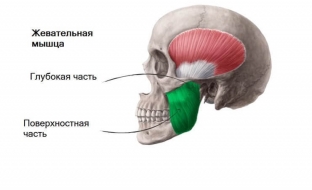Changes in the lower third of the face, which significantly deform it and indicate the activation of the aging process, often become the key reason that prompts patients to turn to a cosmetologist, sometimes for the first time. In this case, they count on immediate cosmetic help and may be very surprised by the recommendations of the beautician about the need to consult a neurologist and orthodontist to correct age-related changes. Nevertheless, the hypertonicity of the masticatory muscles, which has developed against the background of stress or certain diseases of the dentoalveolar system, often causes the manifestation of premature signs of facial aging. Why this happens, and how to correct such a defect, our portal found out.
Why chewing muscles can influence the appearance of signs of aging
The muscles of the head, which provide the process of chewing, originate from the base of the skull and are attached at the other end to the lower jaw. These are chewing and temporal muscles, medial and lateral pterygoid muscles. All of them are innervated by the trigeminal nerve, participate in the work of the temporomandibular joint.
If, for any reason, the masticatory muscles spasm for a long time, then periosteum hypertrophy occurs at the place of their attachment, due to which the lower jaw visually becomes heavier, and the temporal muscles begin to stand out strongly, giving the face a "square" shape. form.
Troubles of spasm, hypertonicity of the masticatory muscles are also in the fact that in this state they pull up the edges of the lower jaw, because of this, the height of the lower third of the face decreases. The consequences of such deformation may be as follows:
- there is an excess of the soft tissues of the cheek, which begin to sag;
- the outflow of fluid worsens and microcirculation in the lower third of the face is disturbed, due to which tissue trophism suffers;
- creeps form on the face;
- "floats" oval face;
- nasolabial and labio-chin folds are aggravated.
If the condition of masticatory muscles is not taken into account when correcting age-related changes in the face, then the effect of procedures aimed at lifting soft tissues, restoring lost volumes and increasing skin elasticity will be incomplete and short-lived.

Some Causes of Hypertonicity of Masticatory Muscles
One of the most common causes of masticatory muscle hypertonicity is temporomandibular joint dysfunction, which is one of the most common dental diseases, although its symptoms are often not correlated with dentoalveolar problems. The reasons for the development of such dysfunction are very extensive: these are stress, and mistakes of dentists, and malocclusion, and even excessive sports loads.
Another common cause of masticatory muscle hypertonicity – chronic stress. Prolonged psycho-emotional imbalance often causes a person to involuntarily clench his teeth, gradually leading to muscle spasm in the lower jaw. In addition, stress has an extremely negative effect on the condition of the skin, worsening its blood supply and accelerating the loss of tone.
How to determine if a patient has hypertonicity of masticatory muscles
When taking anamnesis, ask the patient if he has teeth grinding (bruxism), frequent headaches, earaches, ear congestion, muscle pain in the neck.
Most often, dysfunction of the temporomandibular joint, which causes hypertonicity of the masticatory muscles, is manifested by clicks in the lower jaw when the patient yawns, chews or simply opens his mouth, as well as frequent pains in the temples, the back of the head and even in the shoulders.
When examining a patient, it is necessary to palpate the masticatory and temporal muscles, ask him to open his mouth and determine if there is a click of the joint when opening, whether the mouth opens wide enough (normally 4 cm or more), whether there are abrasions of the teeth, displacement of the central axis lower jaw, malocclusion. If these signs are present, then before cosmetic correction of the face, the patient is recommended to consult an orthodontist, a dentist.
Possible ways to correct the signs of aging caused by hypertonicity
If the hypertonicity of the masticatory muscles and the associated deformities of the lower third of the face are caused by psycho-emotional causes, then the introduction of botulinum toxin preparations can be an effective way of correction, due to which the muscles will relax and the habit of clenching the teeth will go away.
Caution should be exercised when injecting botulinum toxin into the masticatory muscles for problems with the temporomandibular joint, as their relaxation can destabilize the joint and disturb the postural balance of the body.
The dentist may recommend wearing occlusal splints (caps) to correct hypertonicity. As alternative or complementary methods for relaxing spasmodic masticatory muscles, speech therapy exercises and vocal classes give a good effect.
Thanks to a comprehensive interdisciplinary approach involving different specialists, the result of the correction of the lower third of the face will be effective and last for a long time, preventing the premature development of signs of aging.







Add a comment